Work-Related Musculoskeletal Disorders with Days Away From Work Reported by Employers
This indicator measures the number of individuals reported by employers to have missed days of work due to a musculoskeletal disorder. Musculoskeletal disorders include carpal tunnel syndrome, injury to the neck and shoulders, or injury to the back. (Another indicator for carpal tunnel syndrome is based on workers’ compensation claims.)
Musculoskeletal disorders usually develop due to overuse of muscles, bad posture, or repeated movement. Work-related musculoskeletal disorders are preventable. With the correct controls and efficient ergonomic design in place, employees can avoid injuries caused by repetitive stress movements and improper body alignment.
State and national data on occupational injuries and illnesses are derived from the annual Survey of Occupational Injuries and Illnesses (SOII) conducted by the Bureau of Labor Statistics (BLS) in collaboration with the states. The SOII collects data on non-fatal injuries and illnesses for each calendar year from a sample of employers. However, SOII does not include small farms, federal employees, self-employed, and household workers. The employers are required to provide information on injury or illness cases that result in one or more lost workdays, restricted work activity, job transfer, loss of consciousness, or require medical treatment (other than first aid). National and state data are available from the BLS web site. In Minnesota, the Department of Labor and Industry (DLI) compiles these cases and reports on an annual basis and the data are presented in great detail in DLI’s annual Minnesota Workplace Safety Report.
In Minnesota in 2014, there were an estimated 7,370 cases of musculoskeletal disorders involving days away from work among private sector employees, for an annual rate of 392 per 100,000 ful-time workers. Of the total 7,370 cases of musculoskeletal disorders in 2014 in private industry, 2,110 were neck, shoulder, or upper extremity injuries; 280 were carpal tunnel injuries; and 3,200 were back injuries.
Number and Rate of All Musculoskeletal Disorders Involving Days Away from Work in Minnesota, Private Sector, 2000-2014
| Year | Number | Rate per 100,000 Full-Time workers |
| 2000 | 14,872 | 805 |
| 2001 | 11,833 | 667 |
| 2002 | 12,025 | 687 |
| 2003 | 9,940 | 558 |
| 2004 | 9,770 | 563 |
| 2005 | 9,000 | 500 |
| 2006 | 8,730 | 473 |
| 2007 | 9,460 | 467 |
| 2008 | 7,410 | 398 |
| 2009 | 6,710 | 372 |
| 2010 | 7,240 | 416 |
| 2011 | 7,200 | 407 |
| 2012 | 7,030 | 396 |
| 2013 | 6,950 | 381 |
| 2014 | 7,370 | 392 |
Number of All Musculoskeletal Disorders Involving Days Away from Work in Minnesota, Private Sector, 2000-2014
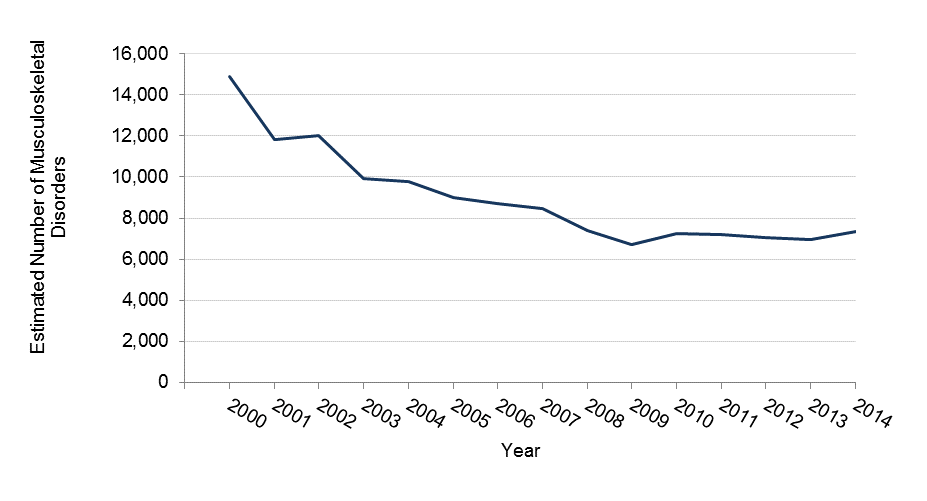
Incidence Rate of All Musculoskeletal Disorders Involving Days Away from Work per 100,000 Full Time Workers, Private Sector, 2000-2014
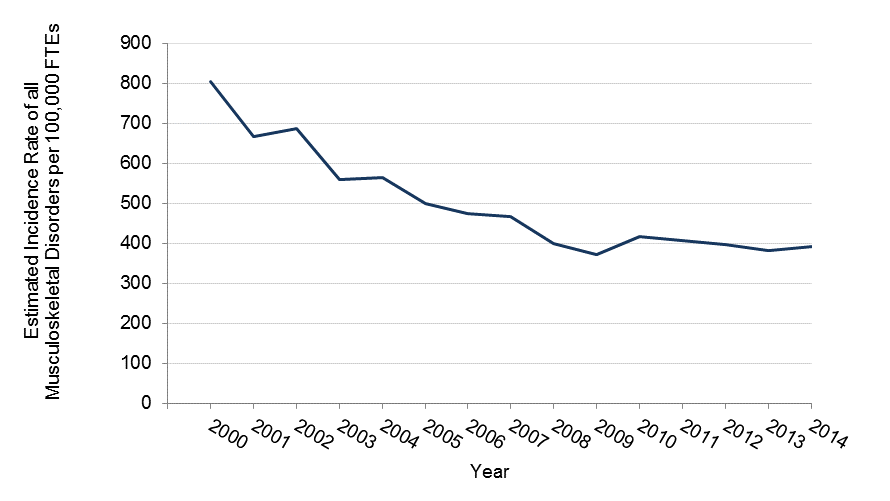
Number and Rate of Musculoskeletal Disorders of the Neck, Shoulder, and Upper Extremities Involving Days Away from Work in Minnesota, Private Sector, 2000-2014
| Year | Number | Rate per 100,000 Full-Time Workers |
| 2000 | 1,962 | 115 |
| 2001 | 3,347 | 189 |
| 2002 | 3,335 | 191 |
| 2003 | 2,750 | 154 |
| 2004 | 3,100 | 178 |
| 2005 | 2,390 | 133 |
| 2006 | 2,550 | 139 |
| 2007 | 2,240 | 123 |
| 2008 | 2,110 | 113 |
| 2009 | 1,710 | 95 |
| 2010 | 1,980 | 114 |
| 2011 | 1,820 | 103 |
| 2012 | 2,220 | 125 |
| 2013 | 2,380 | 130 |
| 2014 | 2,110 | 113 |
Number of Musculoskeletal Disorders of the Neck, Shoulder, and Upper Extremities Involving Days Away from Work in Minnesota, Private Sector, 2000-2014
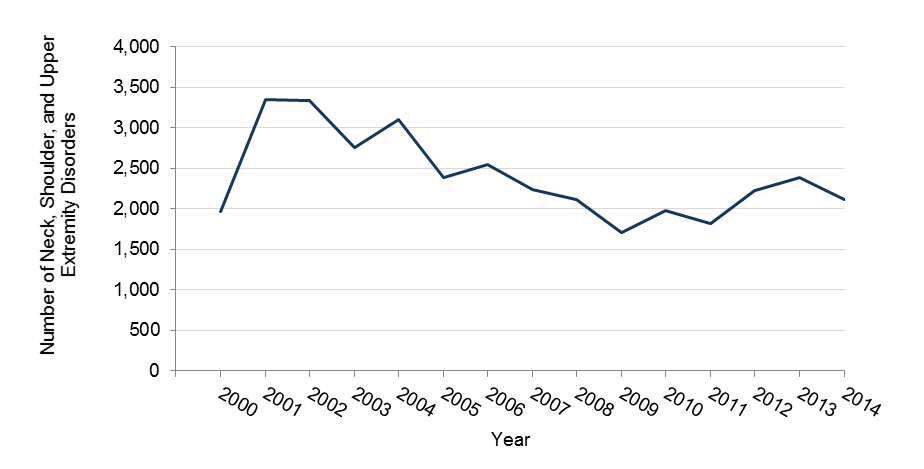
Incidence Rate of Musculoskeletal Disorders of Neck, Shoulder, and Upper Extremities Involving Days Away From Work per 100,000 Full-Time Workers in Minnesota, Private Sector, 2000-2014
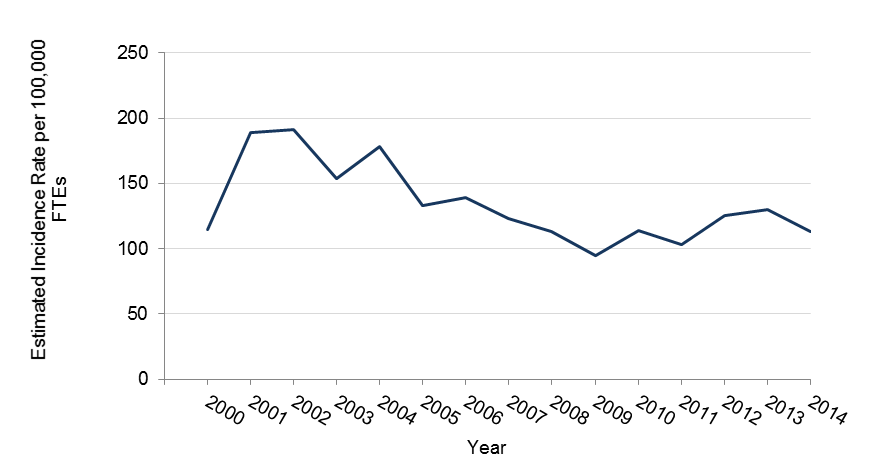
Number and Rate of Carpal Tunnel Syndrome Cases Involving Days Away from Work in Minnesota, Private Sector, 2000-2014
| Year | Number | Rate per 100,000 Full-Time Workers |
| 2000 | 875 | 47 |
| 2001 | 666 | 38 |
| 2002 | 808 | 46 |
| 2003 | 630 | 35 |
| 2004 | 550 | 32 |
| 2005 | 360 | 20 |
| 2006 | 590 | 32 |
| 2007 | 350 | 19 |
| 2008 | 300 | 16 |
| 2009 | 310 | 17 |
| 2010 | 310 | 18 |
| 2011 | 120 | 7 |
| 2012 | 140 | 8 |
| 2013 | 210 | 11 |
| 2014 | 280 | 15 |
Number of Carpal Tunnel Syndrome Cases Involving Days Away from Work in Minnesota, Private Sector, 2000-2014
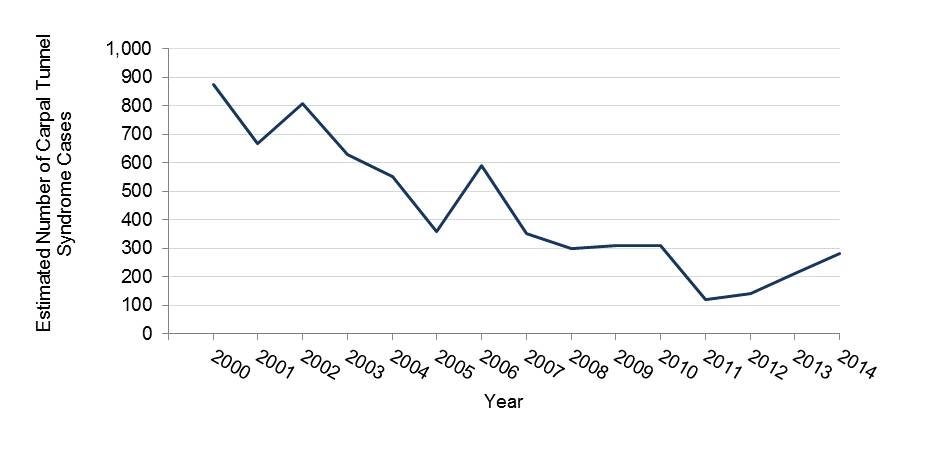
Incidence Rate of Carpal Tunnel Syndrome Cases Involving Days Away From Work per 100,000 Full-Time Workers in Minnesota, Private Sector, 2000-2014
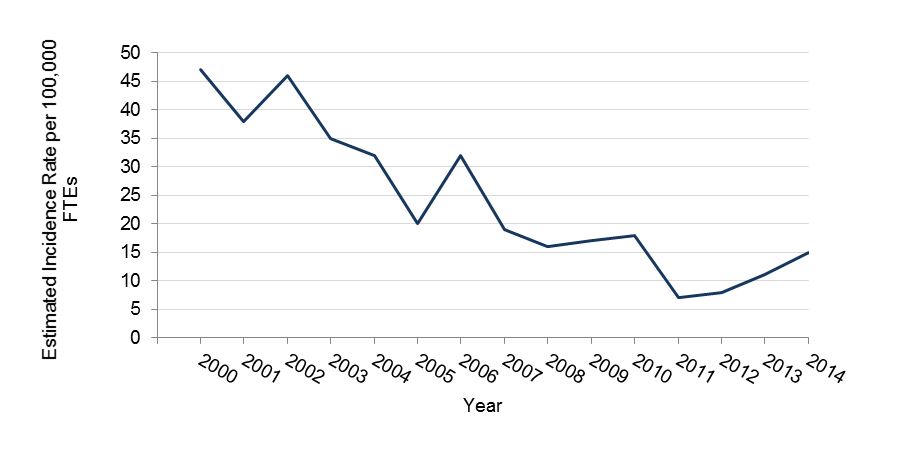
Number and Rate of Musculoskeletal Disorders of the Back Involving Days Away from Work in Minnesota, Private Sector, 2000-2014
| Year | Number | Rate per 100,000 Full-Time Workers |
| 2000 | 4,509 | 263 |
| 2001 | 6,425 | 362 |
| 2002 | 6,470 | 369 |
| 2003 | 5,250 | 294 |
| 2004 | 4,820 | 278 |
| 2005 | 4,720 | 263 |
| 2006 | 4,490 | 243 |
| 2007 | 4,250 | 234 |
| 2008 | 3,910 | 210 |
| 2009 | 3,680 | 204 |
| 2010 | 3,950 | 227 |
| 2011 | 3,550 | 201 |
| 2012 | 3,220 | 181 |
| 2013 | 3,160 | 173 |
| 2014 | 3,200 | 170 |
Number of Musculoskeletal Disorders of the Back Involving Days Away from Work in Minnesota, Private Sector, 2000-2014
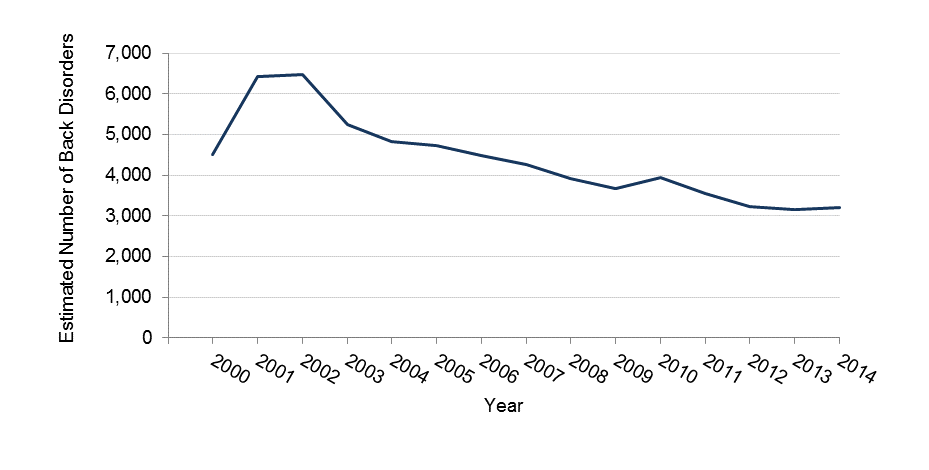
Incidence Rate of Musculoskeletal Disorders of the Back Involving Days Away from Work per 100,000 Full-Time Workers in Minnesota, Private Sector, 2000-2014
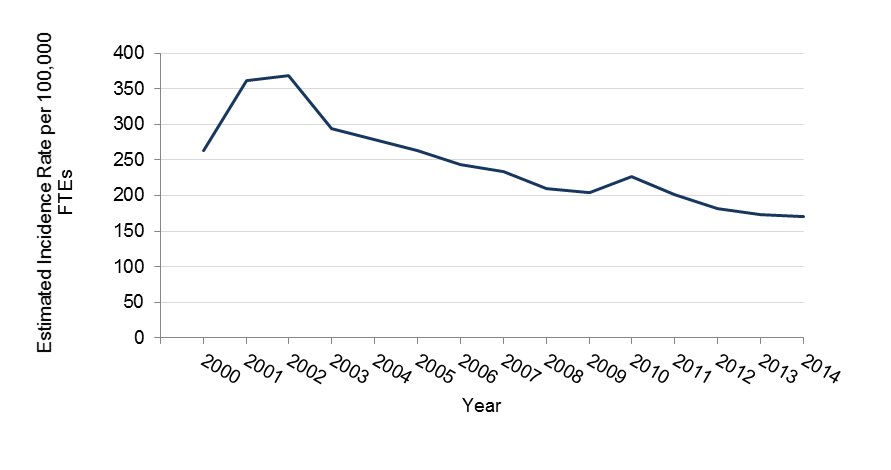
Trend analysis of this indicator demonstrates a statistically significant decrease in the number of musculoskeletal disorders reported by employers between 2000 and 2014. This decline may be a product of the introduction of ergonomic interventions and education regarding proper body alignment and support when performing job duties. As this indicator is based on a sample of industries using employer-provided records, an undercount in the number of musculoskeletal disorders is very likely. Even though this indicator may not be a complete count, it does provide an understanding of the rates and trends of musculoskeletal disorders that occur each year and the continued need for both surveillance and intervention programs to further reduce work-related musculoskeletal disorders.
For resources on ergonomics and how to prevent musculoskeletal disorders, as well as research regarding musculoskeletal disorders please visit the National Institute for Occupational Safety and Health’s website.